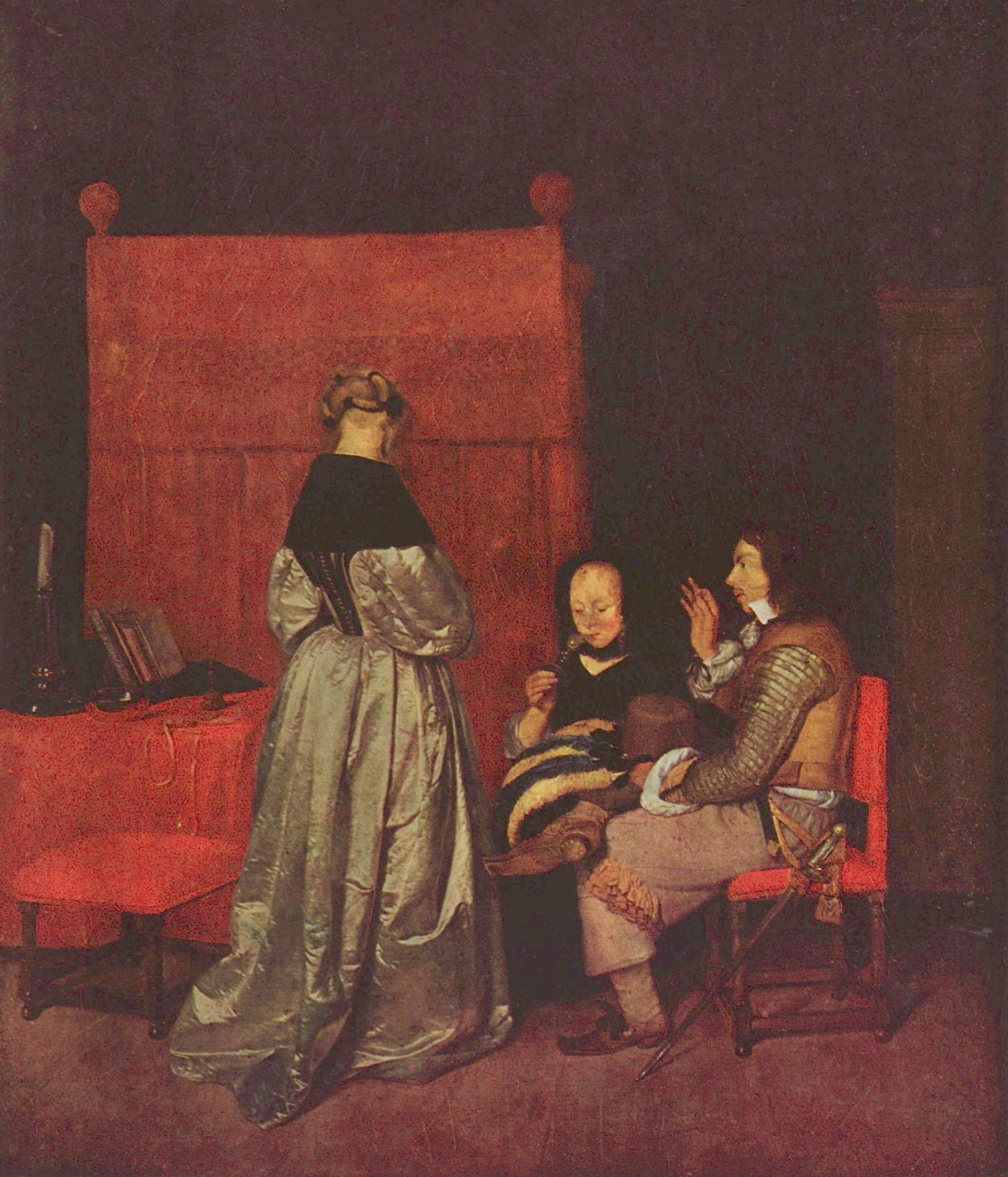- The Gallant Conversation
title=The Gallant Conversation
artist=Gerard ter Borch
year=c.1654
type=Oil-on-canvas
height=71
width=73
height_inch=28
width_inch =28¾
museum =Rijksmuseum
city =Amsterdam ,Netherlands "The Gallant Conversation" is an oil-on-canvas painting from circa 1654 by
Gerard ter Borch (the Younger). For many years it was known as "The Paternal Admonition", and was believed to show a father reprimanding his daughter, but modern commentators see it as a conversation between two prospective lovers, either a discussion of a betrothal or, more likely, a customer propositioning a prostitute in a brothel.Painting
The painting shows a man talking to a young woman. The woman is dressed in an exquisite silver satin gown which immediately draws the viewer's attention to her as the focus of the scene, while the man is in military dress and holds a finely decorated hat on his lap. Next to the man sits an older woman smoking a pipe, seemingly uninterested in the conversation between the man and the girl. To the side of the girl is a table with a burning candle, mirror, powder puff, combs and a trailing ribbon. Behind the man's chair, a scruffy dog can be seen, and to the rear of the picture is a large bed.
Interpretation
During the 19th and early 20th centuries viewers believed the scene showed the father of the girl addressing her on the subject of some misdemeanour, while her mother sat patiently beside him, sipping a glass of wine. There were several problems with this interpretation though, and later appraisals focused on the interaction between the man and the girl as potential lovers rather than as father and daughter. The figure formerly identified as the father, who is clearly a soldier, and had appeared too young to be the father of the girl and the husband of the elderly woman, fitted more easily in the role of suitor. Both a formal situation, in which the man is discussing betrothal to the attentive girl, and a transaction in a
brothel have been suggested as the subject. The details in the painting are ambiguous enough for Ter Borch to have left it to the viewer to decide which of these scenes was being portrayed.Ter Borch made a number of copies of the work, and when a smaller version held in the
Gemalde Gallery inBerlin was cleaned, it was revealed that the man was holding a coin between the fingers of his raised hand; it has been suggested that this makes the brothel scene more likely to be the correct interpretation since it is harder to reconcile the showing of money in a formal situation. However, many of the details of the painting can be placed equally well in either situation. The old woman can be viewed as either the girl's procuress or her attentive mother. The fine dress of the girl and the attention she has paid to her appearance, witnessed by the articles on the table, could be to attract a customer or equally, to secure a husband. The dog behind the chair is reminiscent of many similar depictions of domestic scenes of the time, but here it is a scruffy cur rather than a pamperedspaniel . Nevertheless, the stiff upright pose of the girl is more suggestive of a formal setting than of the louche atmosphere of a brothel. The painting hints at the underlying sensuality, with the large bed looming over the scene, the accoutrements of female beauty on the table, and the abundant feathers in the soldier's cap, but this does not rule out a formal scene, as Ter Borch's contemporaries would have been aware of the ultimate similarities between the two situations. The appearance of the bed close by is not necessarily indicative of a brothel scene either: in the 17th century the bed would have been an expensive piece of furniture to been shown off in the best room. The room is sparsely furnished apart from the bed, chairs and table though, so there is little clue as to the location to be derived from the furniture.Copies
The picture seems to have been immediately popular. Ter Borch himself made copies, and there are at least 24 known other versions by other artists. It was also featured in
Samuel van Hoogstraten 's "The Slippers ", partially visible on a wall in the background. The girl can be seen clearly but the rest of the scene is obscured by a door.References
*cite book|title=Rijksmuseum Amsterdam: The Masterpieces|author=Marleen Dominicus-van Soest|publisher=Rijksmuseum Amsterdam|date=2003
*cite web|url=http://www.rijksmuseum.nl/aria/aria_assets/SK-A-404|title=The Gallant Conversation|date=|publisher=Rijksmuseum Amsterdam|accessmonthday=18 October|accessyear=2007
*cite web|url=http://www.nga.gov/education/classroom/pdf/terborch-tp.pdf|title=Gerard Ter Borch|date=2004|publisher=National Gallery of Art, Washington|accessmonthday=18 October|accessyear=2007
Wikimedia Foundation. 2010.

